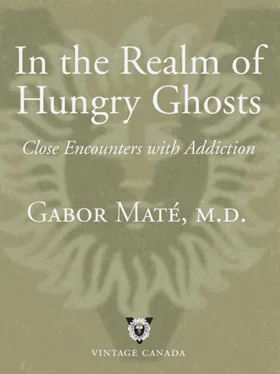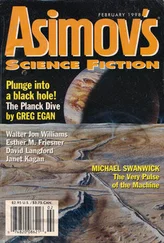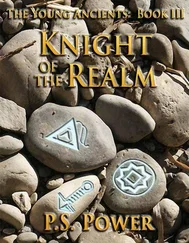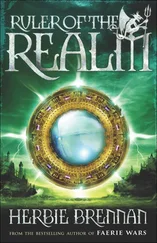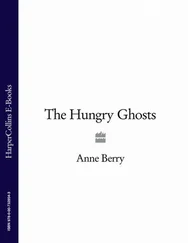It is invigorating to operate in an atmosphere so far removed from the regular workaday world, an atmosphere that insists on authenticity. Whether we know it or not, most of us crave authenticity, the reality beyond roles, labels and carefully honed personae. With all its festering problems, dysfunctions, diseases and crime, the Downtown Eastside offers the fresh air of truth, even if it’s the stripped, frayed truth of desperation. It holds up a mirror in which we all, as individual human beings and collectively as a society, may recognize ourselves. The fear, pain and longing we see are our own fear, pain and longing. Ours, too, are the beauty and compassion we witness here, the courage and the sheer determination to surmount suffering.
CHAPTER 2

The Lethal Hold of Drugs

Nothing records the effects of a sad life so graphically as the human body.
NAGUIB MAHFOUZ
Palace of Desire
From behind his lectern at an East Hastings funeral chapel, the elderly priest proclaims the world’s farewell to Sharon. “How exuberant and joyful she was. ‘Here I am, Sha-na-na!’ she announced as she burst into a room. On seeing her, who could not feel glad to be alive?”
Behind the family the mourners are dispersed through the sparsely filled chapel. A group of Portland staffers are present, along with five or six residents and a few people I don’t recognize.
The young Sharon, I’ve been told, was model beautiful. Hints of that beauty still remained when I met her six years ago, traces gradually erased by her increasingly pallid complexion, sunken cheeks and decaying teeth. In her last years Sharon was often in pain. Two large patches on her left shin were denuded of skin by injection-induced bacterial infections. Reinfection caused repeated skin grafts to slough off, leaving the flesh continually exposed. The exasperated plastic surgeons at St. Paul’s Hospital considered further intervention futile. In her chronically swollen left knee a bone abscess lurked, flaring up every so often and then subsiding. That osteomyelitis was never fully treated because Sharon couldn’t endure the six to eight weeks of hospitalization required to complete the intravenous antibiotic regimen—not even when it appeared that amputation might be the only alternative. Unable to weight-bear owing to her inflamed knee joint, Sharon became hostage to a wheelchair in her early thirties. She’d propel it along the Hastings sidewalk at astonishing speed, employing her strong arms and her right leg to boost herself along.
The priest tactfully avoids evoking the pain-haunted Sharon, whose drug obsession drove her back to the Downtown Eastside, but honours her vital essence.
“Forgive us, Lord, for we do not know how to cherish…Life is eternal, love is immortal…For every joy that passes, something beautiful is created…,” intones the priest. At first all I hear is a litany of funerary clichés and I am annoyed. Soon, however, I find myself comforted. In the face of untimely death, it occurs to me, there are no clichés. “For always Sharon, that voice, that spirit…For the peace of eternity, immortal peace…”
The quiet sobbing of women vibrates in counterpoint to the priest’s consoling words. Closing the book on the lectern, he looks solemnly around the room. As he steps off the podium, music is piped in: Andrea Bocelli crooning a sentimental Italian aria. Mourners are invited to pay their last respects to Sharon, who rests in an open coffin below the stage. One by one they walk up, bow their heads and step back to honour the family. Beverly, cocaine-induced pick marks disfiguring her face, approaches the coffin. She supports Penny, who is bent over her walker. The two were close friends of Sharon. Tom, whose hoarse, alcohol-fuelled evening bellowing resounds up and down Hastings, is dressed in his finest. Stone sober and sombre in white shirt and tie, he bows in prayerful silence over the flower-decorated bier and crosses himself.
Sharon’s white-powdered face wears a naïve, uncertain expression, rouged lips closed and slightly awry. It occurs to me that this faintly befuddled, childlike look probably reflects the inner world of the live Sharon more accurately than the raucous character she often presented in my office.
Sharon’s body was found in her bed one April morning. She lay there on her side as if in dreamy repose, her features undistorted by pain or distress. We could only guess at the cause of death, but overdose was the best surmise. Despite her long-standing HIV infection and her low immune counts, she had not been ill, but we knew she was heavily into heroin use since she’d left the recovery home. There was no drug paraphernalia in her room. It seems she’d injected whatever killed her in a neighbour’s apartment before returning to her own.
The failed attempt at rehabilitation saddened everyone who cared for her. By all accounts she’d appeared to be doing well. “Another four weeks without injection, Maté,” she’d proudly report during her monthly telephone calls. “Send in my methadone script, would you? I don’t want to come there to pick it up—I’ll just be pulled into using again.” Staff visiting the recovery shelter reported that she was vibrant, in good colour, cheerful and optimistic. Despite her heroin relapse, her death was a shock, and even now, with her body laid out in the chapel, hard to accept. Her vivacity, cheer and irrepressible energy had been so much a part of our lives. After the priest’s kind and celebratory words, Sharon should have stood up and walked out with the rest of us.
Service over, the mourners mingle in the parking lot for a while before going their separate ways. It’s a bright, dazzling day, the first time this year the spring sun has shown its face in the Vancouver sky. I say hello to Gail, a Native woman who’s bravely approaching the end of her third month without cocaine. “Eighty-seven days,” she beams at me. “I can’t believe it.” It’s no mere exercise in willpower. Gail was hospitalized for a fulminant abdominal infection two years ago and had a colostomy to rest her inflamed intestines. The severed segments of bowel should have been surgically rejoined long before now, but the procedure was always cancelled because Gail’s intravenous cocaine use jeopardized the chances of healing. The original surgeon has declined to see her again. “I booked the OR for nothing at least three times,” he told me. “I won’t take another chance.” I couldn’t argue with his logic. A new specialist has reluctantly agreed to proceed with the operation, but only under the strictest understanding that Gail will stay off the cocaine. Failing this last opportunity, she may, for the rest of her life, discharge her feces into the plastic receptacle taped to her belly. She hates having to change the bag, sometimes several times a day.
“How ya doin,’ Doc,” says the ever-affable Tom, lightly kneading my shoulder. “Good ta see ya. You’re a good man.” “Thanks,” I say.
“So are you.” Still supported by her hefty friend Beverly, skinny little Penny shuffles up. She leans on her walker with her right hand, shading her eyes against the noon day sun with the left. Penny has only recently finished a six-month course of IV antibiotics for a spinal infection that has left her hunch-backed and weak-legged. “I never expected to see Sharon die before me,” she says. “I really thought in hospital last summer I was a goner.” “You were close enough to scare even me,” I reply. We both laugh.
I look at this small cluster of human beings gathered at the funeral of a comrade who met her death in her mid-thirties. How powerful the addiction, I think, that not all the physical disease and pain and psychological torment can shake loose its lethal hold on their souls. “In the Nazi Arbeit [work] camps back in ’44 when a man was caught smoking one cigarette, the whole barracks would die,” a patient, Ralph, once told me. “For one cigarette! Yet even so, the men did not give up their inspiration, their will to live and to enjoy what they got out of life from certain substances, like liquor or tobacco or whatever the case may be.” I don’t know how accurate his account was as history, but as a chronicler of his own drug urges and those of his fellow Hastings Street addicts, Ralph spoke the bare truth: people jeopardize their lives for the sake of making the moment livable. Nothing sways them from the habit—not illness, not the sacrifice of love and relationship, not the loss of all earthly goods, not the crushing of their dignity, not the fear of dying. The drive is that relentless.
Читать дальше
